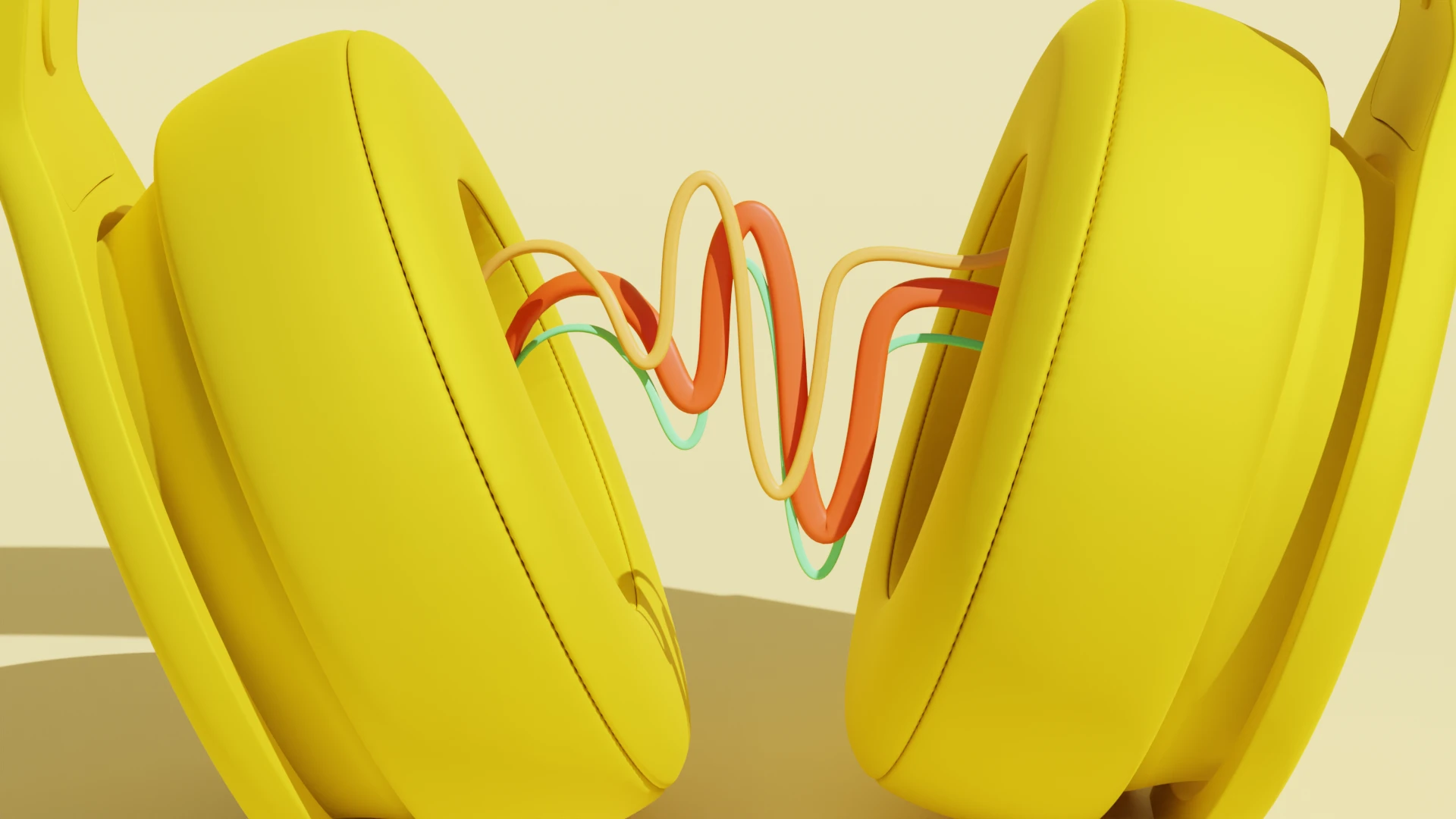At Descript, we have a different take on choosing a microphone to make a podcast: we don’t think it matters all that much.
If you’re just starting out as a creator, you shouldn’t invest in an expensive mic—maybe not even a moderately priced mic.
Start small—you could even use the mic on your laptop—then move your way up. With the availability of new recording technology and editing tools like Studio Sound, you can make a podcast that sounds just fine without spending a cent.
As you get deeper in, of course, you’ll start to care more about your sound. And that’s when you can invest a bit more in your recording gear.
Regardless of where you are in your podcasting career, whether you’re just starting out or a seasoned podcaster ready to upgrade your microphone, you’ll want to understand a little about the functionality that today’s microphones offer. Because there are a lot out there, from condenser microphones for studio recordings to USB microphones for gaming headsets. Finding the right mic comes down to understanding your specific needs and knowing your options.
So which one should you buy? Well, it depends on who you ask. That’s why we’ve put together a list of nine podcast microphone recommendations, and the important considerations for choosing one.
Best podcast microphones
1. Blue Yeti
 |
Like we said, when you’re just getting started, the mic in your phone or laptop can work just fine and won’t cost you a penny. If you're editing in Descript and apply Studio Sound, it will sound great. If you have an Apple iPhone, recording into your voice memo app is another great way to go—just be sure to hold it to your cheek, like a phone, rather than in front of your face.
If you’re ready for a step up, former Descript product specialist Kevin O'Connell recommends the Blue Yeti USB condenser microphone. Plug it into your laptop via USB cable, use the built-in webcam if you’re recording a video podcast, and you're off.
Specs:
- Type: Condenser
- Connection: USB
- Pattern: Cardioid
Pros:
- Plug-and-play ease.
- Multiple pickup patterns.
- Built-in headphone jack.
- Sturdy build.
Cons:
- Picks up background noise.
- No XLR output.
- Can be pricey.
Price: $129.99
2. Shure Beta 87C
 |
As for what Kevin uses, he prefers the Shure Beta 87C. This is a popular choice for recording studios and individual setups alike. He likes how it picks up every aspect and frequency of his voice, especially how it captures his lower, warmer tones without losing clarity or diction. It's also rugged as all get out.
"You can drop it a bunch," he says. It is kind of expensive, at around $250. This is the mic you want if you're already up and running, you've hit your stride on production, you're ready to up your sound, and you've got $250.
Specs:
- Type: Condenser
- Connection: XLR
- Pattern: Cardioid or Supercardioid
Pros:
- Clear vocal reproduction.
- Low handling noise.
- Built for live settings.
- Consistent sound.
Cons:
- Pricey.
- Requires phantom power.
- Pop filter needed.
Price: $259.00
3. RØDE PodMic
 |
Tom’s Guide recommends the RØDE PodMic—an XLR mic for just around $100 with an internal pop filter. It’s small but doesn’t come with a mic stand, and Tom’s likes the “fantastic sound” it delivers. Remember, you’ll need an interface, which is probably another $100-plus. The FocusRite Scarlett 2i2 is a popular option for that, but it will set you back about $180.
Specs:
- Type: Condenser
- Connection: XLR
- Pattern: Cardioid
Pros:
- Affordable.
- Built for podcasts.
- Durable build.
- Clear voice pickup.
Cons:
- Mic stand not included.
- XLR only.
Price: $99.00
4. Apogee HypeMic
 |
PCMag recommends the Apogee HypeMic. At nearly $350, their favorite USB mic is a pricier one, but they like its clarity and the fact that it comes with analog compression. Plug your headphones directly into the built-in headphone jack for a studio-like experience. This option even comes with a windscreen to avoid any breath noise with your vocals.
Specs:
- Type: Condenser
- Connection: USB
- Pattern: Cardioid
Pros:
- Great sound quality.
- Built-in compressor.
- USB connectivity.
- Portable.
Cons:
- Pricey.
- No XLR output.
- Limited physical controls.
- May overprocess sound.
Price: $349.00
5. RØDE Procaster
 |
The RØDE Procaster is an excellent option for broadcasters who already have podcast equipment handy, like an audio interface or a mixer. Overall, it delivers pleasing sound that doesn’t require a ton of editing to clean up.
The Procaster is a dynamic mic built for recording speech, with a tight cardioid pattern that keeps it tethered to your voice and minimizes background noise. Its wide frequency range and built-in shock absorption make it versatile and forgiving enough to be used in many different environments.
Specs:
- Type: Dynamic
- Connection: XLR
- Pattern: Cardioid
Pros:
- Rich vocal quality.
- Minimal ambient noise.
- Sturdy construction.
- Built for broadcasts.
Cons:
- Large and heavy.
- Low signal output.
- Needs a good preamp.
Price: $229.00
6. Shure SM7B
 |
The Shure SM7B is one of the most expensive microphones on our list, making it best for the seasoned podcaster. This mic is loved by professional musicians for its top-notch performance and nose-attenuating technology that produces clear recordings. It’s definitely one for podcast veterans or aspiring professionals.
The SM7B is built like a tank. Its all-metal construction ensures it can withstand the rigors of daily use without showing signs of wear and tear. With its adjustable mounting bracket, you can easily position the SM7B at the exact angle you need.
Overall, the SM7B offers a smooth, flat frequency response from 50 Hz to 20 kHz, making it versatile for both voice and instruments. Plus, it offers bass rolloff and mid-range emphasis controls to reduce room noise and add clarity to vocals.
Specs:
- Type: Dynamic
- Connection: XLR
- Pattern: Cardioid
Pros:
- Industry standard.
- Excellent noise rejection.
- Wide frequency range.
- Smooth voice reproduction.
Cons:
- Expensive.
- Requires strong preamp.
- Heavier build.
- XLR-only.
Price: $399.00
7. Audio-Technica AT2035PK
 |
The Audio-Technica AT2035PK comes with the full package—mic, microphone stand with boom arm, and headphones—making it one of the best podcast mics for beginners. It’s a condenser mic with an XLR connection, so it’s professional enough to produce high-quality audio files for each episode.
With its sleek, black matte finish, the AT2035 looks premium and can complement most studio setups. Overall, it offers a balance of performance and value, but will need an audio interface or mixer that supplies phantom power to make the most of it.
Specs:
- Type: Condenser
- Connection: XLR
- Pattern: Cardioid
Pros:
- Good value bundle.
- Clear sound reproduction.
- Versatile.
- Comes with accessories.
Cons:
- Requires phantom power.
- Not the most sturdy build.
- Better for beginners.
Price: $199.00
8. Samson Q2U
 |
The Samson Q2U is the best budget microphone on our list. Coming in at just around $70, this is great for beginning podcasters who want to try something other than their built-in Mac or Windows computer recorder.
One of the standout features of the Q2U is its dual XLR and USB connectivity. This makes it a versatile choice because you can connect directly to a computer via USB or a mixer or interface via XLR. The Samson Q2U is a fit for podcast recording or live streaming for YouTube and Twitch streamers.
Specs:
- Type: Dynamic
- Connection: USB & XLR
- Pattern: Cardioid
Pros:
- Affordable.
- Dual USB/XLR output.
- Includes accessories.
- Handy headphone jack.
Cons:
- Less professional sound.
- Shorter lifespan.
Price: $69.99
9. Shure MV7
 |
The final Shure microphone on our list is the Shure MV7. It offers an XLR and USB connection, ensuring it fits into any podcast studio. The MV7 can automatically adjust gain and compression settings via USB, guaranteeing a consistent audio level.
The MV7 features a touch panel for real-time headphone volume, mic gain, and mix control adjustments. With a unidirectional cardioid polar pattern, the MV7 excels at focusing on the voice and rejecting ambient sound, much like its predecessor, the SM7B.
Overall, the MV7 is a high-end microphone without a huge price tag. Coming in right around $250, this is a middle-of-the-road price point for a high-quality voice recording.
Specs:
- Type: Dynamic
- Connection: USB & XLR
- Pattern: Unidirectional
Pros:
- Dual USB/XLR output.
- Touch panel controls.
- Good sound isolation.
- Inspired by SM7B.
Cons:
- Some report connectivity issues.
- Might be overkill for some.
Price: $249.00
5 things to consider before buying a mic
There are different mics for different jobs. Your choice of hardware should depend on what you’re looking to record. Kevin offers a few considerations to keep in mind as you scour the web for the right microphone:
Frequency response
As Kevin explains it, frequency response is the biggest element in giving a mic its ineffable character. “We all have our 'soul mate' out there when it comes to microphones,” he explains, “and frequency response is one of the foundational principles for finding your perfect match.”
The highest quality mics can capture sounds across the frequency spectrum. The human ear hears frequencies ranging from about 20 Hz to 20 kHz. Certain iconic mics, like the brilliant but pricey Neumann U87, can capture this entire range from sound sources, while the far more common and affordable Shure SM58 can only capture 50 Hz to 15 kHz—though this still covers most frequencies we can hear. It’s also worth mentioning that you can buy like 37 SM58s (at about $90) for the price of one U87 (which cost about $3,300).
A mic's frequency response will accentuate, tame, or leave alone certain sonic characteristics of your voice. Ideally, you’re looking for the one that will make you sound like the best version of yourself. “Finding a microphone that complements your voice is the key,” Kevin says. You can always try a microphone shootout.
Compatibility
Different types of microphones are compatible with different recording devices. Most mics use three-prong XLR connectors, commonly used with professional audio equipment, but there are other types as well. Here’s the selection you’ll find:
- XLR microphones. XLR mics can connect to almost any mixer or audio interface, though XLR is unique to professional audio setups and isn’t able to connect directly to your laptop or iPhone (for example) without a special adapter.
- ¼ inch connector. You can also get a mic with a ¼-inch male plug, also known as an audio jack, though this plug style can produce background noise from electrical circuits and it also won’t plug directly into your computer. These are the larger versions of 3.5 mm plugs common on headphones.
- USB microphones. USB mics plug directly into your device’s USB ports, making them easy to use and ideal for compact setups. They can’t plug anywhere else, however, and they don’t match the audio quality of XLR mics.
- Bluetooth microphones. The Bluetooth standard compresses audio, which reduces sound quality. That’s why they’re rarely used for studio recording. These are best for when you need to move around on camera, since they don’t have any cords to get in your way.
- Other wireless microphones. Many wireless microphones don’t use Bluetooth. These connect to a receiver via an uncompressed wireless standard, and the receiver connects to a soundboard via XLR cables. These wireless mics sound almost as good as a wired microphone, but they’re more common in live performance than in recording.
Directionality
Different mics pick up sounds in various directions and patterns, described as directional patterns or pickup patterns. “Mic directionality comes into play when you're thinking about what you want to record, and where you're recording it,” Kevin says.
An omnidirectional microphone captures sound from all directions, making it great for micing an entire room. But if you’re focusing on a single speaker or singer, an omnidirectional mic brings in too much background noise. Many podcasters and recording engineers prefer a cardioid polar pattern.
As its name suggests, this common directional pattern looks a bit like a heart, where the heart’s indentation is just behind the mic. It has high sensitivity to sound in front of the mic capsule, slightly reduced sensitivity from the sides, and almost no sensitivity from behind. Other directional options include supercardioid (like cardioid but with more sensitivity behind the microphone), hypercardioid (covering more sound sources behind the mic), bi-directional (capturing an equal amount of sound in front of and behind the mic), and shotgun (capturing a narrow range of sound in front of and behind the mic, with only a little range on either side).
Kevin offers some guidelines for how to approach the choice. “If you're recording in a small space with many different voices sitting around a table, having directional mics for each speaker will be key in isolating one voice from other folks in the room. On the other hand, if you're recording in the field and want to capture the sound of an environment, you’ll want a stereo pair of mics that have broader directionality to capture all the nuances and help transport the listener to that space.”
Type
There are three types of microphones, which vary depending on how they pickup sound and translate that into electrical audio signals.
- A dynamic microphone uses a magnetic field to generate an audio signal. The force of air causes a tiny metal coil suspended within the microphone to move, creating an electrical current that transmits the audio.
- A condenser microphone uses capacitance (a change in electrical voltage) to create audio signals.
- A ribbon microphone suspends a metal ribbon between a magnet’s poles. When air vibrates the ribbon, it induces voltage which goes to a transformer.
Dynamic mics are typically the sturdiest and the easiest to ‘plug and play.’ Condenser and ribbon mics are typically more sensitive and better able to capture audio nuance — the downside is they tend to be more fragile. All condensers, and some ribbon mics, require external electrical current (i.e. phantom power) to work.
Functionality
“Functionality of a microphone comes down to what you'll be putting it through on a day-to-day basis,” Kevin explains. “Is this a mic that sits at home on a desk? Will you be recording in wind and rain with it? Or will you be recording narration on the go?”
Some mics come with functions like a gain control or a mute button on the front of the mic. These tools can come in handy when you suddenly need to silence your mic, but almost never appear on top-quality microphones (barring certain wireless microphones). If you don’t necessarily need a top-of-the-line mic, and if gain control or a mute button sound convenient, look for a microphone that includes these functions.
Once again, you’ll need to think about where you plan to use your microphones. “Mics like the Electro-Voice RE50B are known for their durability and quality results in almost any recording environment,” Kevin says, “but may not be the best in a room with a lot of reverb (unless you want that, of course). Alternatively, AKG 414s are known for their superior quality in the studio, but may cause some issues when trying to record on the go out in the field.”
Final thoughts: Trust your ears
As much as a guide can be helpful, there’s only so much you can glean about a microphone from reading about it. If one or more of these mics sounds intriguing, look for ways to hear it in action. If you have a friend who owns a particular model, ask to try it out. If you live near a music retailer, visit the showroom and ask to demo some mics. Otherwise, YouTube is an excellent resource with all kinds of enthusiasts demoing their audio gear—including plenty of microphones.
Run through our checklist to make sure you’ve gotten everything you need to start a podcast, including the best microphone for your needs.











































